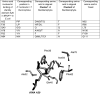Evolutionary Adjustment of tRNA Identity Rules in Bacillariophyta for Recognition by an Aminoacyl-tRNA Synthetase Adds a Facet to the Origin of Diatoms
- PMID: 35325255
- PMCID: PMC8975779
- DOI: 10.1007/s00239-022-10053-5
Evolutionary Adjustment of tRNA Identity Rules in Bacillariophyta for Recognition by an Aminoacyl-tRNA Synthetase Adds a Facet to the Origin of Diatoms
Abstract
Error-free protein synthesis relies on the precise recognition by the aminoacyl-tRNA synthetases of their cognate tRNAs in order to attach the corresponding amino acid. A concept of universal tRNA identity elements requires the aminoacyl-tRNA synthetases provided by the genome of an organism to match the identity elements found in the cognate tRNAs in an evolution-independent manner. Identity elements tend to cluster in the tRNA anticodon and acceptor stem regions. However, in the arginine system, in addition to the anticodon, the importance of nucleotide A20 in the tRNA D-loop for cognate enzyme recognition has been a sustained feature for arginyl-tRNA synthetase in archaea, bacteria and in the nuclear-encoded cytosolic form in mammals and plants. However, nuclear-encoded mitochondrial arginyl-tRNA synthetase, which can be distinguished from its cytosolic form by the presence or absence of signature motifs, dispenses with the A20 requirement. An examination of several hundred non-metazoan organisms and their corresponding tRNAArg substrates has confirmed this general concept to a large extent and over numerous phyla. However, some Stramenopiles, and in particular, Diatoms (Bacillariophyta) present a notable exception. Unusually for non-fungal organisms, the nuclear genome encodes tRNAArg isoacceptors with C or U at position 20. In this case one of two nuclear-encoded cytosolic arginyl-tRNA synthetases has evolved to become insensitive to the nature of the D-loop identity element. The other, with a binding pocket that is compatible with tRNAArg-A20 recognition, is targeted to organelles that encode solely such tRNAs.
Keywords: Aminoacyl-tRNA synthetase; Bacillariophyta; Diatoms; Identity element; Non-metazoan eukaryotic evolution; tRNA.
© 2022. The Author(s).
Conflict of interest statement
The author has no competing interests to declare that are relevant to the content of this article.
Figures




References
MeSH terms
Substances
LinkOut - more resources
Full Text Sources

